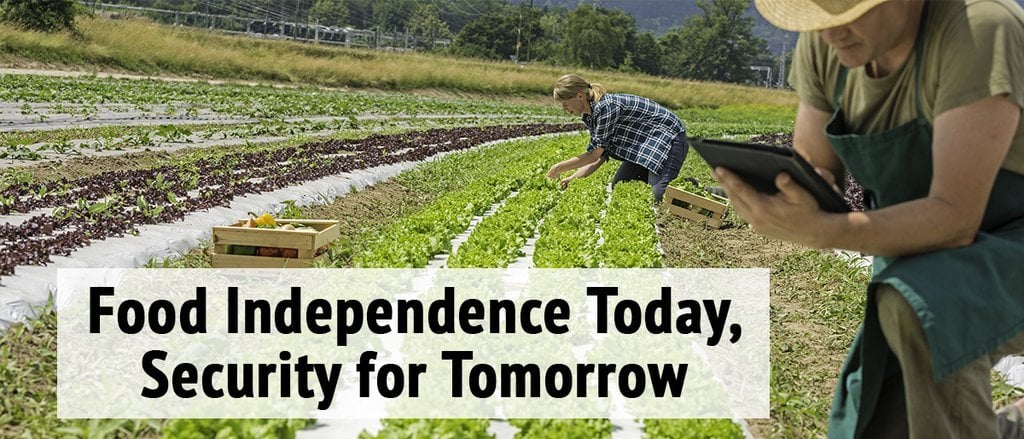
The global food supply is a vast, complex and ultimately fragile system. For years, news of crop failures, shortages and contaminated foods have been making mainstream news.
These disruptions have a direct impact on the food that’s available to us and how much we pay for it at the market. But, they’re normal, given the enormity of the system. Most disruptions do not mean people who normally have easy access to food suddenly starve. Yet, the possibility of a severe disruption that leads to cascading shortages still looms.
The bigger threat? A disruption from outside. For example, war and terror have caused huge disruptions and shortages in food supplies throughout history.
Those of us who are planning to survive the worst atrocities imaginable must always remember this mantra:
In order to rebuild civilization, we must sow it with seed.
 Why Worry About Seeds?
Why Worry About Seeds?
Here in the United States, the typical grocery store carries less than 72 hours’ worth of food on its shelves, with no back stock. When a disaster strikes the U.S. (not if, but when), there will be mad rushes to those stores and the food and water will be gone quickly. And that “disaster” could take many forms. It could be weather or terrorist-related, or it could be a financial meltdown. Regardless, food could be very difficult to come by. Unless you are prepared.
The best way to be completely prepared for a food shortage? Acquire, store, plant and harvest seeds. It’s essential to stockpile non-perishable food, but no one knows how long a crisis will last. Depending on what happens, you may find yourself in a position of having to feed your family for an extended period of time, perhaps well over a year. You can do it, but only if you are prepared.
Yet, Saving is Not Enough
In order for your survival seeds to be worth the effort of storing, you must know how to grow them. Reading the planting and harvesting instructions is not enough. You must practice by gardening now.
Gardening can be as complex or as simple as you want to make it. But a few seasons of growing experience is the only way to find out what works and what doesn’t for you.
 Plus, the benefits are incredible. You can save as much as $1000 per year. You get the freshest produce, mere steps from the kitchen.
Plus, the benefits are incredible. You can save as much as $1000 per year. You get the freshest produce, mere steps from the kitchen.
If you’ve never tried growing your own food before, I suggest you start small. With less crop to tend to, your success rate will automatically be higher. This will give you the confidence to build out your garden and start becoming truly self-sufficient.
For more specific instructions, I suggest you seek out your local extension services or a master gardener in your area. These resources are often very helpful and open with information that is tailored to your region, your soil and your climate.
However, as I said before, it can be as simple as buying some high-quality heirloom seeds, tilling your soil and planting them. Raised beds and rows are nice, but again, not necessary.
The important thing is that you get in the habit of gardening now. It prepares you for the future and feeds you now – win-win.
How to Never Buy Seeds Again
The process is not easy – it will require work on your part – but it is simple.
First, you need non-hybrid, open-pollinated, non-genetically modified seeds with high germination rates. Heirlooms. Even better if they’re organic.
 Second, plant those seeds in a garden.
Second, plant those seeds in a garden.
Third, store your unused seeds for the future. Finally, harvest the seeds from your current plants.
If you are successful in doing those four things, you’ll never have to buy seeds again. This way, you’re set up for the immediate needs of a short-term emergency and ready if the crisis is prolonged.
If you already have a garden, collect the seeds from your plants and store them. You’ll want to time your harvest based on the individual plant's method of seed dispersal, clean your seeds and spread them out to dry, label them properly and store them in secure containers in a cool, dark, dry place.
If all of this information has made you interested in starting your own garden, our Patriot Seed Vault is a great place to start.
The Patriot Seeds Organic Seed Vault contains all USDA-certified organic, 100% heirloom seeds. No GMOs, no hybrids – ever. It’s the easiest way to declare your food independence. Many folks buy one for planting now and save the other with their emergency food storage.
No matter how you do it, invest in your self-reliance and long-term survival today.
Get to work on your Patriot Garden.
Have a great weekend, friends. Stay safe and alert out there!
In Liberty,
Elizabeth Anderson
Preparedness Advisor, My Patriot Supply
P.S. To learn more about self-reliance, follow MPS on Facebook or Twitter.


